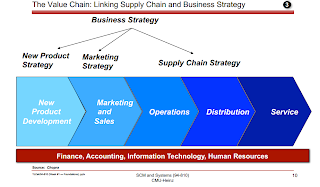In the last class, our focus was on understanding what supply chain management is. It was interesting to discuss how companies like Dell, Wal-Mart and Cisco used supply chain management to give them strategic advantage over their competitors.
As the discussion moved on, my mind kept coming back to how the same concept applied to some new products of the digital age, such as electronic books, audio books and digital music sales online. Traditional supply chains are indeed complex structures, over large geographical locations but are they also complex for digital goods?
We discussed the following strategic supply chain decisions that companies need to take:
– Locations and capacities of facilities
– Products to be made or stored at various locations
– Modes of transportation
– Information systems
The question I would like to address today is that do these decisions apply to digital products? Does the producer need to decide where he wants to sell his e-book or it is assumed that he will do so online? Does the concept of inventory management apply at all? Does the product need to be transported, other than being available to download from the Internet? Is there a need for setting up a separate information system to enable the process or is an e-commerce website enough to cater to this?
The fact that there is no inventory makes digital products an interesting and attractive business opportunity. Whether you sell one unit or a thousand units, the inventory and production need not be worried about. Moreover, accessibility is not an issue. The remotest of areas in the world can be accessed, provided they have Internet access.
Essentially, the supply chain model we studied for physical goods needs extensive modification.
Observe the snapshot of the slide we studied. For an e-book, the producer needs a ‘New Product Strategy’ and a ‘Marketing Strategy’, however, there is little a supplier can do to modify the supply chain strategy. There may be some requirement of ‘Services’ as well, but it will certainly not be as elaborate as the traditional supply chain. Hence the new model would become:
New Product Strategy > Marketing Strategy > Distribution
It is common knowledge that the Internet has facilitated the starting of many businesses by cutting various costs. We can see that most of the cost cutting can be attributed to the supply chain management and the producers can completely focus their energies on the product development and marketing it. Since the product is digital, even the marketing channels are narrowed down to Internet and mobile applications advertising to reach out to the relevant market.

No comments:
Post a Comment
Note: Only a member of this blog may post a comment.